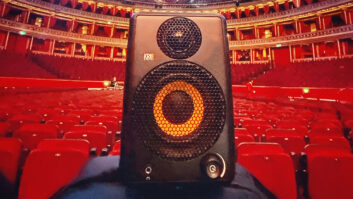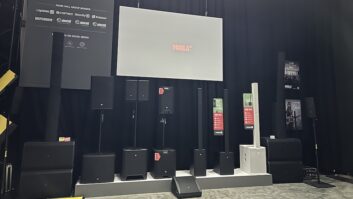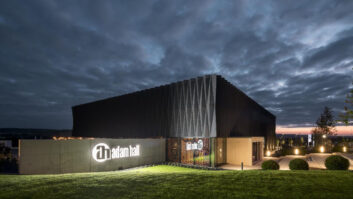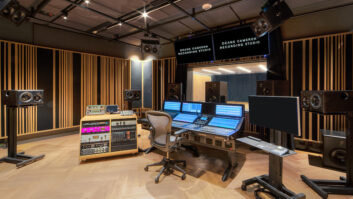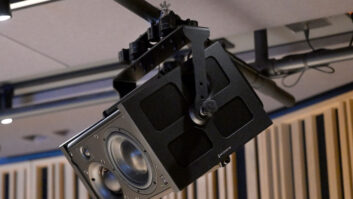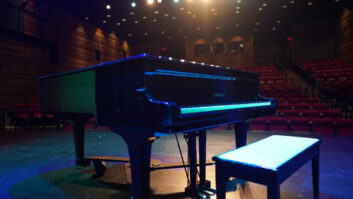––RG Jones’ Simon Honywill Propels Martin Audio Award-Winning System
As Classical Extravaganza Takes Sonic Leap Forward––
Sound rental company, RG Jones has been producing sound reinforcement infrastructure for the challenging Raymond Gubbay Classical Spectaculars at the Royal Albert Hall since 1993.
With a production harnessing cannons, pyro and lasers in a festival type ‘Proms’ atmosphere, it has taken all of FOH engineer Simon Honywill’s expertise to keep the show’s audio fidelity evolving with each generation of new technology.
Honywill is no stranger to Martin Audio proprietary line array platforms, introducing W8L Longbow systems to the Glastonbury Pyramid stage, and taking the new MLA (Multi-Cellular Loudspeaker Array) system on tour with Jeff Wayne’s War Of The Worlds.
Rigging the MLA at the Royal Albert Hall for the first time ever this month, he knew the Classical show would experience the same dynamic range and sudden transients as War of the Worlds––and in a venue notoriously difficult to control, he also knew it would clean up the room’s inherent reflections. But the performance, he said, was breathtaking, and even beyond his expectations.
“We’ve made a massive leap forward with the MLA … the results were remarkable,” reported Honywill.
At the RAH, the two front arrays comprised 16 element MLA hangs per side, with no downfill enclosures, since the rig’s trim height was 40 ft. (from the lowest box) to accommodate the huge lighting rig. Side hang arrays of nine Martin Audio W8LM mini enclosures were balanced with a single W8LMD underneath to bring coverage down as far as possible; at the same time, a central sub-bass array of six WLX was recessed under the stage apron, which was electronically curved to optimize coverage.
Martin Audio’s Nigel Meddemmen became de facto systems engineer, walking the entire room to verify uniform sound balance. “The challenge was to match the warmth and smooth response of the MLA, a tricky task particularly on some of the operatic pieces with shrill soprano vocals which have a tendency to really show up deficiencies in the high frequency of a system.”
Meddemmen recounted that the design software was critical in ensuring optimum performance. “The calculations were based on Simon’s model of the slice through the venue, and with the advantages of the new Display 2.1 software, Ambrose [Thompson, Martin Audio Electroacoustic Engineer] was able to design a system with the correct splay angles.”
Stated Simon Honywill, “The fact that it sounded so astounding is testament to the software. In fact I have never heard a system [in the RAH] that sounded so similar upstairs as down. Ambrose was also able to rationalize the coverage to effectively reduce the amount of energy hitting the balcony fronts––other systems have claimed it but this is the first to deliver.”
The design prediction created ‘voids’ precisely where necessary––including the elimination of any stage spill, as Simon Honywill was quick to attest. “You could stand under the MLA on stage and not hear a thing!
“But at the same time this is the loudest I have been able to drive a system here without the orchestra moaning!”
The program combined the traditional ‘greatest hits’ from the classical canon with new works such as Karl Jenkins’ Benedictus from The Armed Man; A Mass For Peace. The latter swings from the gentlest of solo cello to five percussionists hitting a variety of drums extremely hard and the choir adding weight to a huge sonic picture.
“We had ten mics on the choir and I found I could keep opening them up massively, with no coloration whatsoever,” noted Honywill. “We’ve never had the amount of level, definition and control––particularly with the low strings––as we achieved with the MLA, and that is what makes it sound really fat. It was a pleasure and absolute joy to mix.”
Summing up, the sound engineer said, “To get the sonic quality and level required by the promoters you can’t afford for the system to be in any way obtrusive. It has to sound really sweet when loud, warm and powerful––and intelligent and delicate at the same time. MLA was all of these things and more.”
For more about Martin Audio, please click to www.martin-audio.com.
About MLA™ (Multi-cellular Loudspeaker Array)
The result of many years of intensive R&D, MLA’s methodology replaces trial-and-error array design with intelligent numerical optimization of the array’s output based on a highly accurate acoustic model. The multi-cellular format has six individual cells in each enclosure, each with its own DSP and amplification.
With up to 24 enclosures, each MLA array has up to 144 cells — too great a number to optimize manually, or by ear. Instead, Martin Audio’s proprietary Display2™ system design software automatically calculates FIR DSP filters for each cell and a redundant-ring audio network (U-NET™) downloads the settings into each array enclosure. Martin Audio’s VU-NET™ software provides real-time control and monitoring of the system.
MLA delivers a frequency response and SPL consistency never before achievable; a very high system output (140dB peak, per cabinet @1m); Automatic optimization of the array, both physically (splay angles) and electronically (DSP); Computer control and monitoring of the entire system, and total control of sound system balance for engineers and sound technicians.
MLA is fully integrated, with Class D amplification, DSP and U-NET digital audio
network built into each enclosure. MLA complete systems are ready-to-use, with MLA, MLD and MLX enclosures, flying hardware, software, cabling and training all supplied. Everything needed is included. All ancillary items — from tablet PC and Merlin™ controller to network interconnects and mains distro — are also included in the complete system package. This ensures full compatibility worldwide, down to cabling and accessories.
Additional features include 90° x 7.5° dispersion; a compact size (1136mm wide x 372mm high x 675mm deep), one-box-fits-all (festivals to theaters) application range and a global voltage, power factor corrected power supply.
MLA’s compact size and very high output allows it to be shipped using smaller trucks, offering considerable savings and reduced carbon footprint. The system also includes the MLX powered, flyable subwoofer capable of an unprecedented measured peak output of 150dB @ 1m; MLD downfill cabinet, and Merlin 4-in/10-out system controller and network hub. Audio input is via analog, AES3 or U-NET.
By adopting these principles and system components MLA is optimized for every member of the audience — from a 2,000 capacity theater, to a 20,000-seat arena, to a 100,000-person festival site. It will deliver the engineer’s exact mix to every seat (up to over 150 meters) with precision, exceptional power and clarity.
About Martin Audio®
Founded by audio engineer David Martin in 1971, Martin Audio pioneered the use of all-horn-loaded bass designs in world-class touring loudspeaker systems for groups such as Pink Floyd, ELP and Supertramp. Located outside of London, Martin Audio now embodies a sophisticated mix of acoustic design, research, mathematical modeling and software engineering for a wide range of products in the installation, cinema and touring sound markets.

